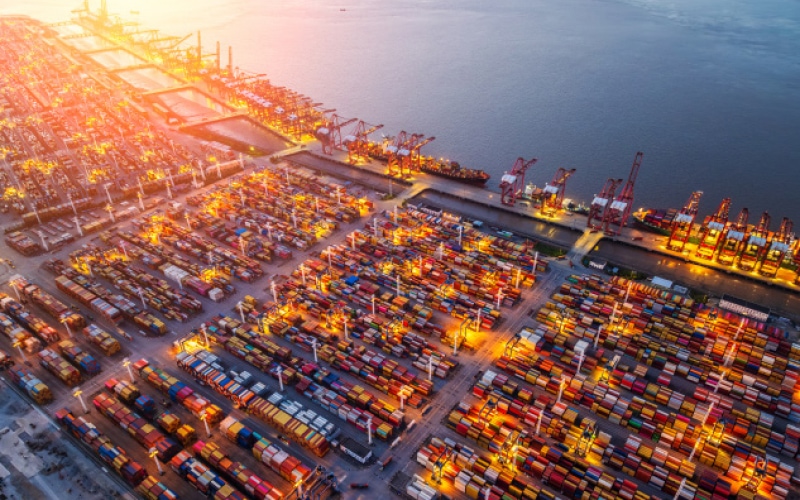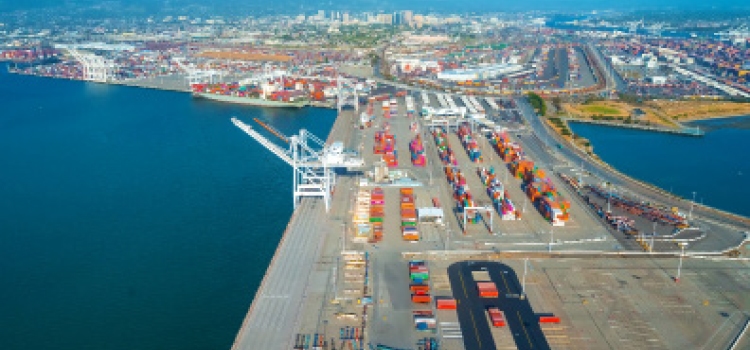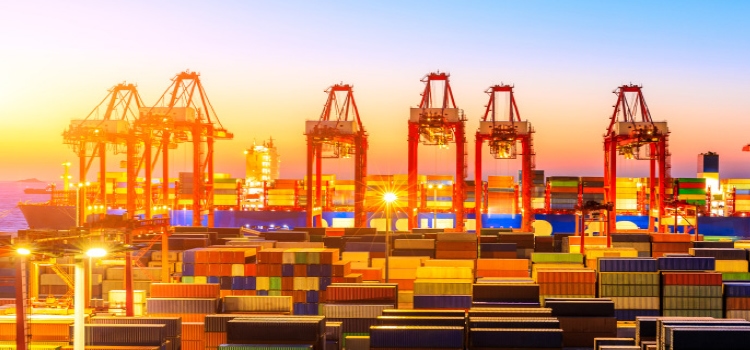Global Logistics: Key Trends and Takeaways

The only certainty when it comes to global logistics is ongoing uncertainty. Agility, technology, and an appreciation for geopolitics are among the abilities essential to navigating the current environment.
Cross-border tensions, environmental concerns, advancing technology, and related worries about cybersecurity are among the forces shaping today’s global supply chain and logistics operations. Moreover, a return to normal—say, the years before the pandemic—appears unlikely.
Every year lately, “a big unknown” has impacted supply chains, says Leo Qvarnström, director, Sea-Air Logistics and air sustainability, North America with Kuehne+Nagel, a provider of logistics services. Recent examples include the war in Ukraine, the ecommerce boom, and the current conflict in the Red Sea.
The acronym VUCA, which has its roots in the military and stands for volatility, uncertainty, complexity, and ambiguity, is now being used to describe the world of commerce, says Tom Goldsby, executive director of the Global Supply Chain Institute at the University of Tennessee, Knoxville. Supply chain and logistics professionals can gain an edge by understanding the trends and shifts contributing to the current global logistics environment.
Geopolitical Upheaval
In addition to exacting a human cost, conflict impacts supply chain and logistics operations. For instance, Red Sea attacks are forcing more shipments around the horn of Africa, lengthening cycle times and driving up fuel costs and carbon emissions, says Ted Stank, co-executive director, with Tom Goldsby, of the Global Supply Chain Institute.
Between November 2023 and February 2024, container leasing rates on the China-to-U.S. trade route more than doubled, finds Container Xchange, an online container logistics platform.
Challenges in the Red Sea will even indirectly impact shippers whose cargo doesn’t travel this route, says Robin Knopf, global head of Sea-Air Logistics with Kuehne+Nagel. The reason? As carriers move to avoid the Red Sea, they create disruptions or container shortages along other routes, he adds.
Other trade lanes are also at risk, says the Boston Consulting Group (BCG). One is the Strait of Hormuz, which accounts for 20 to 30% of oil trade. If Iran is drawn into the conflict in the Middle East, vessels navigating this strait could be at risk.
Another lane, the Strait of Malaca, accounts for 30% of global trade. An ongoing dispute between China and several members of the Association of Southeast Asian Nations (ASEAN) over an area in the South China Sea may impact this strait, BCG says.
Along with rising transit costs, it’s likely that confirming bookings will be more difficult by summer 2024. “Companies will need to plan longer lead times for getting goods to their final destinations,” says Christa Pitts, co-CEO with The Lumistella Company, the firm behind Elf on the Shelf.
China Plus One
To offset rising labor and other costs in China, many companies are employing a “China + One” strategy. “Firms are reducing their concentration in China and adding capacity in Southeast Asia, India, and Mexico,” says Marc Gilbert, managing director and senior partner with BCG.
Countries in Southeast Asia, for instance, currently supply multiple regions of the world, including China and North America, Gilbert says. In India, leadership has taken steps to address corruption and enhanced the country’s ability to move goods around, he adds.
Nearshoring/Reshoring
More North American companies also are looking to locate operations closer to home. In early 2023, Mexico replaced China as the United States’ top trading partner, benefiting from its geographic proximity, strong manufacturing-based economy, skilled workers, and free-trade pacts, reports research firm MSCI.
Along with Mexico, all of Latin America offers strong potential for nearshoring, says Rick Jordon, senior managing director with FTI Consulting. Many companies will still need to rely on supply networks based in Asia. However, as Latin American companies implement new technology, it’s possible they’ll leapfrog ahead of their Asian counterparts.
Regionalization

A major gateway for global cargo shipments, the Oakland Seaport in Northern California serves a local market of more than 14.5 million consumers and 50% of the U.S. population by rail.
Interest in regional supply chains is growing. The idea is to “move away from thinking that we have one manufacturing hub for the whole world,” Stank says. Instead, companies can set up regional supply chains, which tend to be more agile, to support their major markets. If operations are disrupted in one area, other locations can compensate.
Artificial Intelligence
“The biggest impact to the global supply chain will continue to be the use of artificial intelligence (AI),” Pitts says. Among other benefits, AI allows supply chains to maximize efficiency in ways that hadn’t been possible previously, such as maximizing space utilization on a container or a pallet.
“AI allows companies to work smarter,” she adds.
Given ongoing disruptions, supply chain transparency and visibility to the sources of goods will factor in planning. “AI can enhance that power,” says Melinda McLaughlin, global head of research with logistics real estate company Prologis.
One company employing AI in the supply chain is Good360 is a nonprofit that distributes product donations through its network of 100,000+ vetted nonprofit partners.
The company is trying to use AI to help determine if it can efficiently move products where they’re needed after an event occurs, says CEO Romaine Seguin.
For example, Seguin has been working with a donor to determine how Good360 can help in areas impacted by wildfires. “We’re bringing in AI technology for mapping weather and identifying how much damage is in an area and what’s needed, such as water or hygiene products,” she says.
Cybersecurity
As supply chains digitalize, the risk of cyber attacks increases. “It’s the flip side of the digitalization and automation coin,” Stank says. Some chief information officers are even throttling back supply chain initiatives because of cybersecurity concerns, he adds.
A criminal may act as a carrier, broker, or even a customer to break into a system and then try to hijack freight or access customer or employee data. “Any system is open to attack,” warns Nathan Johnson, founder and CEO of transportation consultancy GLCS.
Sustainability
While it’s difficult to pin a single weather event on climate change, the drought at the Panama Canal is capturing the attention of supply chain experts. Drought cycles used to occur once every five years, but now are happening every three years, said Ricaurte Vásquez Morales, administrator of the Panama Canal, in a statement.
Another sign of the emphasis on sustainability is the European Commission’s Carbon Border Adjustment Mechanism. CBAM, which will be phased in between 2023 and 2026, is intended to fairly price the carbon emitted during the production of carbon intensive goods entering the EU.
CBAM will initially apply to some goods whose production is carbon intensive and at most risk of carbon leakage, such as cement, iron, and steel; additional goods will be added.
Navigating Evolving Global Logistics
As global logistics evolves, here’s how shippers can adjust.
Strengthen Agility
Resilience remains essential, but it doesn’t mean trying to create bulletproof supply chains. “There is no such thing as being bulletproof,” says Goldsby of the University of Tennessee. Instead, resilience should take the form of agility, or developing options before they’re needed. Plasticity, or the ability to make rapid structural changes, such as sourcing in new locations, is also necessary, he says.
Understand Geopolitics
Supply chain leaders today need to understand a range of subjects, including geopolitics, economics, and cybersecurity, Goldsby says. “They have to be global citizens and understand that what takes place in, say, Indonesia could very much influence their supply chains and business,” he adds.
Create a Task Force
More than three-quarters of respondents to BDO’s Global Risk Landscape 2023 indicated that the risk landscape is shaped more by connections between risks than individual risk factors. Addressing these connections requires a company-wide focus.
Assemble an enterprise-wide task force to take a control tower view of the supply chain, advises Tony Nuzio, founder and chief executive officer with ICC Logistics Services Inc. It should be cross-functional and include employees from all levels. Employees on the ground might be best suited to identify, for instance, suppliers that are critical to production, even if the company purchases relatively small amounts from them. Task force members can run scenarios and assess how prepared the company is for them, he adds.
Beef Up Cybersecurity
Nearly three-quarters of cyber incidents include a human element, such as an employee clicking a phishing link, according to Infosec, a cyber security training company. Employee education is key to preventing attacks.
“All it takes is one person in the organization to click on something they shouldn’t, and then the entire company is exposed,” says Nathan Johnson from consultancy GLCS. Another essential safeguard is multifactor authentication, or requiring users to present two pieces, or factors, that show their identity before they can access a system.
Find Partners or Platforms
The very largest companies may have the resources they’ll need to manage the evolving global logistics environment by themselves. Many other organizations will need to work with partners and/or platforms to achieve the benefits of scale, says Prologis’ McLaughlin.
Global Trade Management Solutions

Technology tools can help shippers tackle the challenges of global logistics operations. Here are a few of the many available solutions.
Descartes: Datamyne™ is a searchable trade database that provides real-time access to import and export information from customs authorities and trade ministries across 230 markets.
e2open: Features on e2open’s global trade management software include due diligence screening, the ability to automate export compliance and import management, as well as a database of government trade regulations.
ImportKey: The AI-driven algorithm leverages global and U.S. import and export data, as well as U.S. customs data and records, to identify top products, sellers, and buyers for given time periods.
Oracle Global Trade Management: This solution allows companies of any size and in all geographies to centrally manage global trade operations and to optimize, automate, and monitor cross-border transactions from a unified trade and transportation platform.
PartnerLinQ: This supply chain platform integrates with more than 70 TMS, WMS, and ERP systems using industry best practices, common workflows, and data structures.
SAP Global Trade Services: This platform integrates trade services across the entire enterprise and automates and streamlines trade processes.
Trademo: This solution connects billions of supply chain data points and leverages software to provide organizations visibility into their global supply chain networks.
Zonos: The platform provides a range of cross-border solutions, like Landed Cost, which offers the ability to show guaranteed duty, tax, and carrier fee calculations on all orders.
